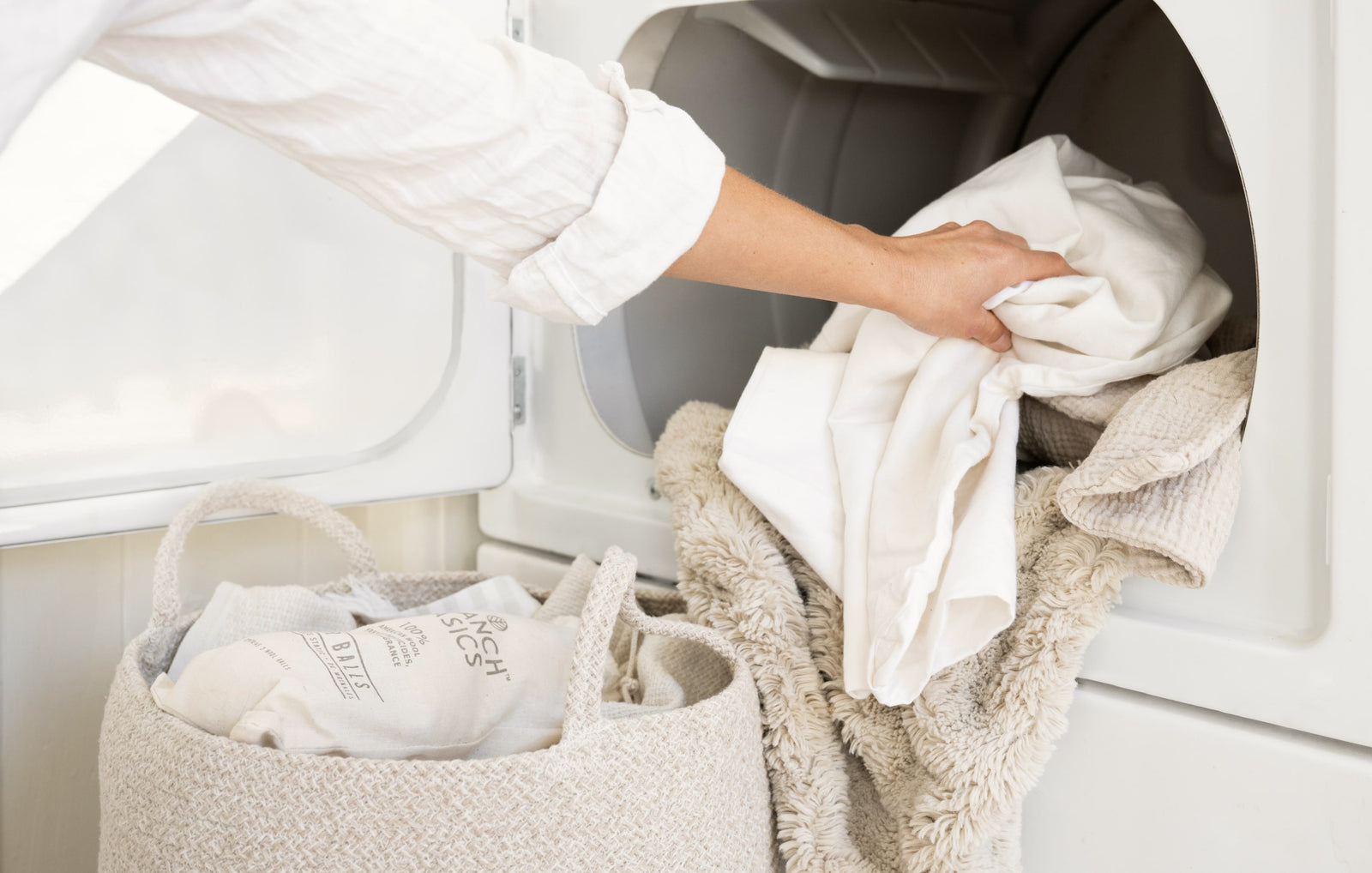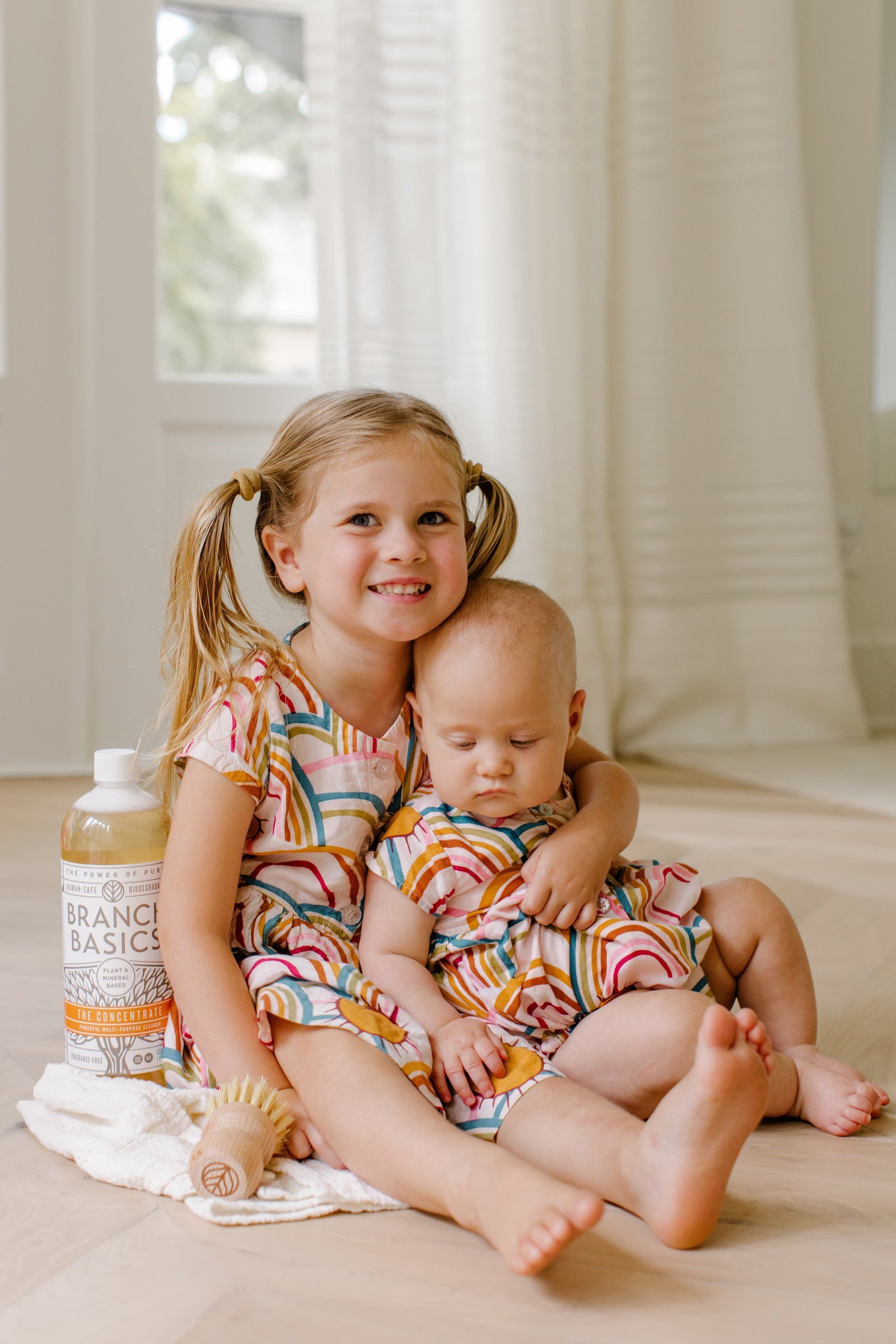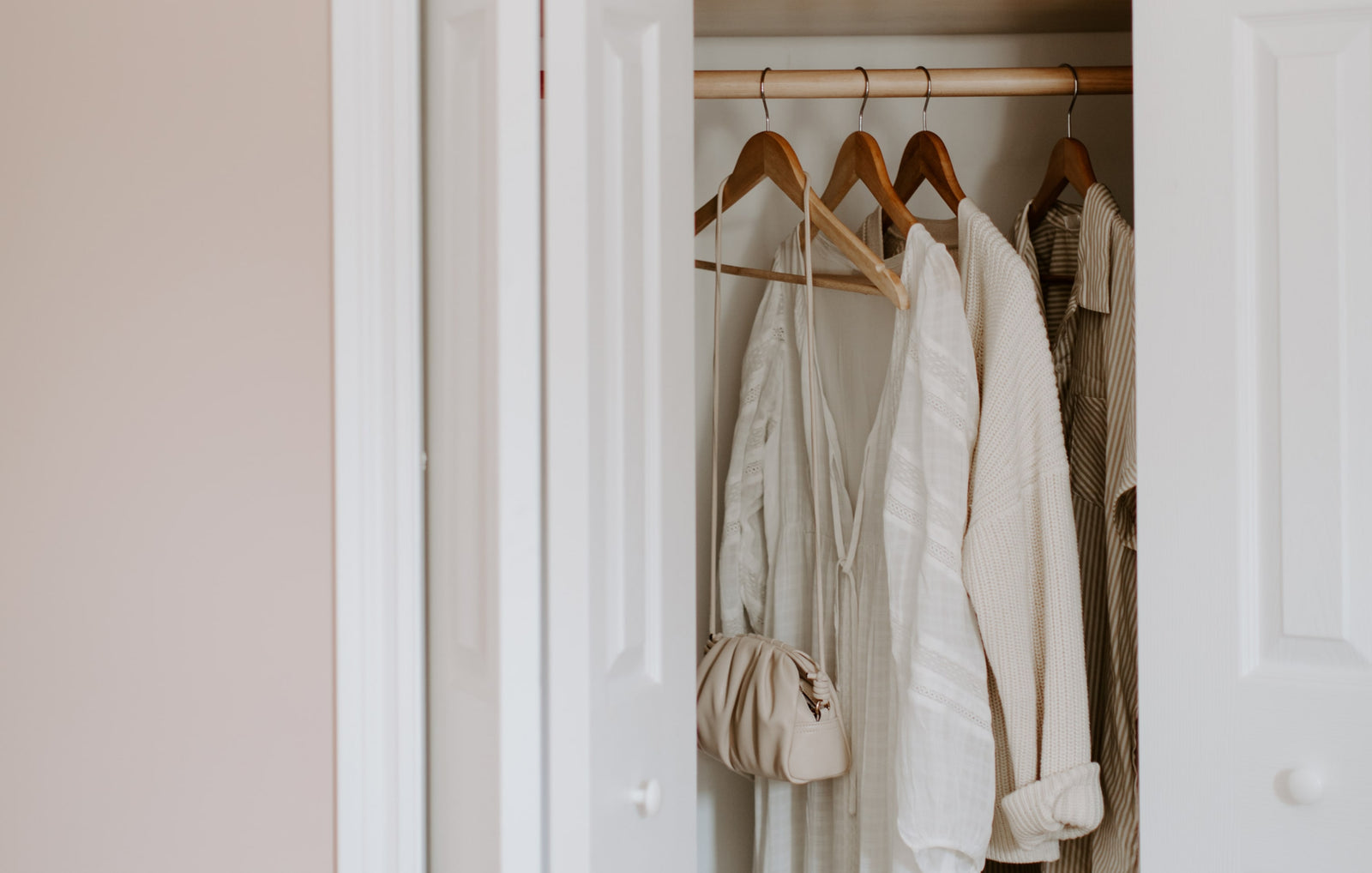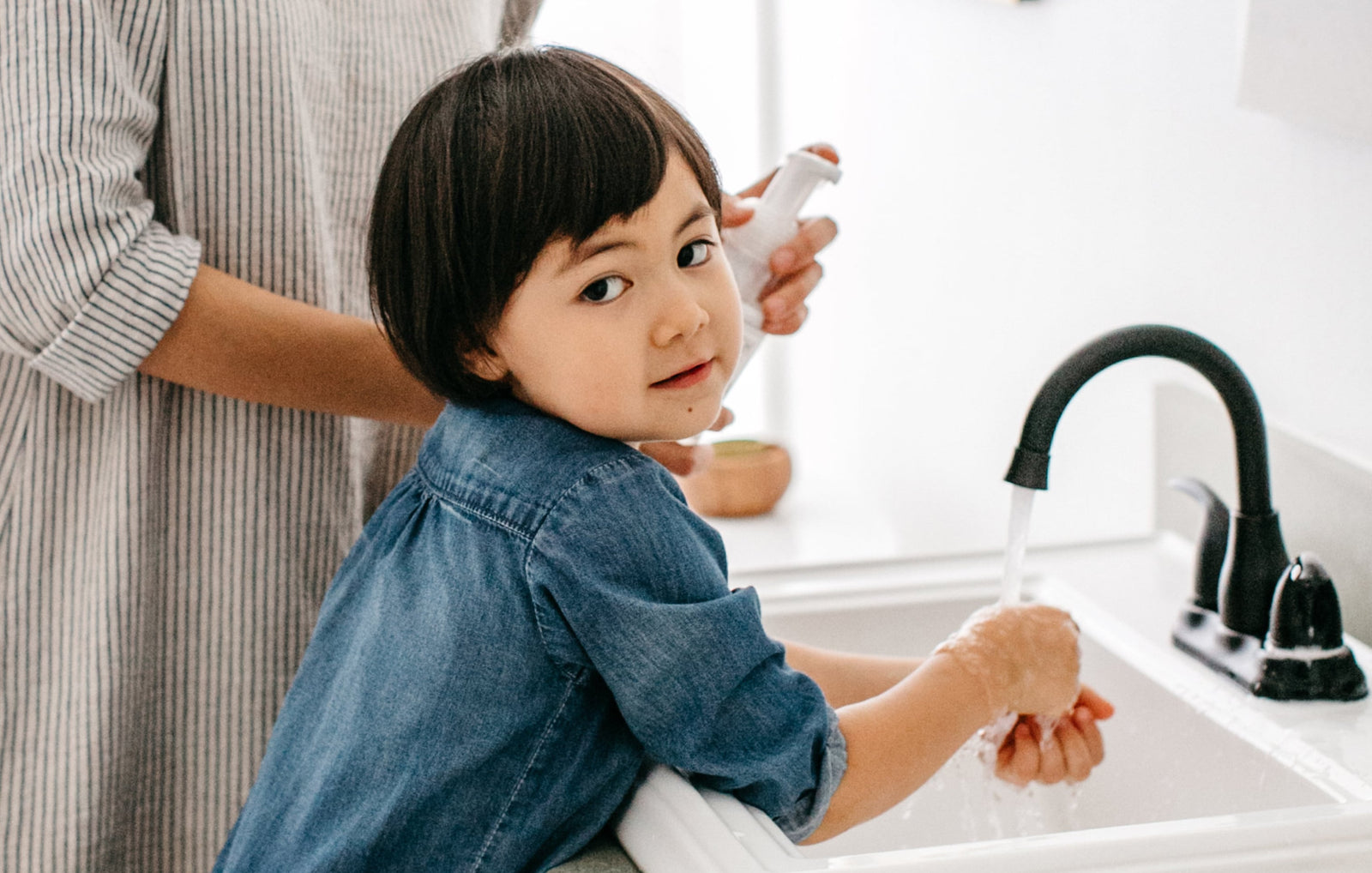Our Guide to Laundry Sustainability | Branch Basics

We talk a lot about the importance of choosing human-safe and environmentally-friendly household products.
One of the areas where this is most important is in the laundry room, also known as the most toxic room in the average American home.
From bleach to fragrance, detergents to microplastic-laden clothing, dryer and detergent sheets, doing laundry releases hundreds of harmful chemicals into our homes, waterways, and the greater environment.
Doing laundry also requires a lot of water and energy—about 10% of an entire household’s energy expenditures, according to Consumer Reports.
Plus, not all “green” laundry products are as safe as they claim.
Fortunately, it’s pretty darn easy to cut down your laundry footprint with these tips and tools from our laundry sustainability guide.
Our Favorite, Sustainable Laundry Practices
We’ve written extensively about how to choose the safest laundry products, including detergents, bleach alternatives, stain removers, dryer sheets, and fabric softeners, as well as how to detoxify your laundry room.
And we’ll talk about some of these in this article, too.
However, using safe and natural laundry products is only half of the equation.
We must also focus on our laundry habits if sustainability is the goal.
Here, we share our favorite sustainable laundry practices to reduce water and energy use while keeping microplastics out of the environment.
1. Wash Fuller Loads
You just bought a cute new top, and you’re dying to wear it right away…should you run a small load?
If reducing your laundry footprint is the goal, handwashing would be a better plan.
Although smaller laundry loads may require slightly less water than larger loads, they still use up a lot of water and energy.
Of course, occasional emergency small loads are sometimes essential, especially with young children or during times of sickness.
However, washing fuller loads is one of the best ways to increase laundry efficiency.
2. Run an Extra Spin Cycle to Reduce Drying Time
Reducing heated drying time is one of the best things you can do to save on energy expenditures.
Although not everyone will be up for line-drying, nearly every washer offers an “extra spin” cycle, which can cut down drying time significantly.
Just set it, forget it, and use the sensing option on your dryer or manually reduce the drying time by 15-20 minutes to save on energy costs.
3. Air Dry
This may not be for everyone, but line-drying clothes can save you hundreds of dollars in annual energy costs.
Air-drying synthetic fabrics also prevents the release of microplastics into the air from heat drying.
A bonus: sunlight acts as a natural bleach alternative and deodorizer (so take care with colors) and will help remove any lingering fragrance/VOCs or unwanted smells from hand-me-downs or consignments.
Tip: Turn your clothes inside out to reduce the chance of fading from sun exposure.
Various clotheslines are available for indoor or outdoor drying, making this process quicker and more efficient than in the past.
The only con is that it takes time to pin everything up, and you must watch the weather if you’re drying outdoors.
Related reading: How To Get Heavy Fragrance Out Of Clothing
4. Wool Dryer Balls
Wool dryer balls are one of nature’s best-kept secrets for softening, de-wrinkling, and removing static from clothes while also reducing drying time.
The secret lies in the absorbent wool, which naturally draws in extra moisture as clothing dries.
Wool dryer balls are also reusable and a lot quieter than plastic dryer balls.
At Branch Basics, we offer a pack of 3 sustainably sourced wool dryer balls from the world’s happiest sheep.
These can be reused for up to 10 years with proper care (talk about economical!) and make the perfect sustainable fabric softener and dryer sheet alternative.
5. In The Market for a New Dryer? Consider One with a Heat Pump
Any appliance that generates heat, like a dryer, oven, hair dryer, etc, uses up a lot of energy.
This is why dryers have been slow to become HE.
However, you can now find HE dryers that run on heat pumps, making them 20-60% more efficient than traditional dryers.
Heat pumps work by drawing heat from the room’s air into the dryer.
Some dryers are 100% heat-pump operated, while others are hybrids.
Unfortunately, heat-pump dryers are much more expensive and slow compared to traditional dryers, making them unrealistic for most people.
However, keep an eye on this technology as it will likely improve over the next few years.
6. Use Sustainable Laundry Detergent
We couldn’t write a sustainable laundry guide without discussing detergent.
As we’ve discussed in other articles, laundry detergents contain some of the most harmful and toxic chemicals, such as harmful synthetic surfactants, bleach, phosphates, 1-4 dioxane, optical brighteners, VOCs, phthalates, and fragrance (to name but a few).
This is why many people choose “green” or “fragrance-free” detergents.
However, this also gets confusing because many self-proclaimed “green” options still contain many harmful chemicals, like fragrance or fragrance-masking chemicals!
Our best advice is to choose human-safe, natural, naturally fragrance-free, and biodegradable laundry detergents with all ingredients rated “1-2” on EWG’s SkinDeep app and database.
Branch Basics Laundry, made with our multi-purpose Concentrate + water, or Branch Basics NEW Laundry Detergent (a water-free option) are both excellent choices for sustainable laundry.
We also highly recommend against using detergent sheets or pods.
Although marketed as low- or no-waste options, new research has shown their “biodegradable” plastic (known as PVA) doesn’t biodegrade as well as initially reported, with up to 75% remaining in waterways after water treatment.
You can learn more about this in: What is PVA? Environmental Impact, Use Cases, & More
Get more laundry detergent recommendations in: 10 Laundry Detergent Alternatives That Actually Work
7. Avoid Using Dryer Sheets to Increase Dryer Efficiency
Dryer sheets are one of the least sustainable laundry products in the world.
They’re single-use, contain some of the most heinous harmful chemicals, and release microplastics into the environment.
Plus, they contain fabric-softening chemicals that slowly coat your dryer, increasing the fire risk (for real) and decreasing the dryer’s efficiency over time.
Instead, use wool dryer balls or check out these other dryer sheet and fabric softener alternatives.
8. Avoid Dry Cleaning
They’re also incredibly harmful to humans and have been linked to an increased risk of cancer, respiratory and eye irritation, organ damage, and other diseases.
According to the CDC, dry cleaning chemicals may also be harmful to pregnant women and unborn babies.
Yes, some clothes must be dry cleaned, but it should be the exception versus the rule.
You can also hand-wash and air-dry many items deemed “dry clean only” to reduce your chemical footprint.
Many cities also have organic or healthier dry cleaning options.
Learn more in: How To Wash Dry-Clean Only Items At Home
9: Use a Guppy Bag to Filter out Microplastics
Microplastics from clothing? Yep, that’s a thing.
Clothing, towels, sheets, etc., made from synthetic fabric, like polyester or microfiber, sheds tiny microplastics during laundering, which wind up in our waterways and soil.
Research has shown even just one load can release millions of microplastics into the environment.
Fortunately, you can prevent this by using a Guppy Friend Bag when you launder synthetic fabrics. Just toss your clothes into the bag and launder as usual.
There are also washing machine filters you can retrofit, which claim to remove 90-90% of microplastics.
These are new products and primarily sold in the UK and EU right now. Since we haven’t used or tested them, we can’t speak to their efficacy or quality, but it’s an exciting development!
So, for now, we recommend a Guppy Bag, but we will circle back on the topic of washing machine filters at a later date.
10. Focus on Clothing Made of Natural Materials
We love our Guppy Friend Bags for washing microfiber cloths and synthetics.
However, we also practice a preventative approach by buying clothing made from natural, plastic-free fabrics like cotton, linen, wool, and hemp.
Learn more about our favorite sustainable clothing brands in: How To Choose Healthy And Sustainable Clothing
11. Get Good at Natural Stain Removal to Reduce Loads
Becoming proficient at removing stains/spot treating versus washing the entire garment is a no-brainer way to enhance your laundry sustainability.
We have loads of articles on natural stain removal, including how to remove wine, marker, oil stains, chocolate, nail polish, and more.
Also, check out our Stainmaster Guide for Branch Basics-specific tips (All-Purpose, Concentrate, and Oxygen Boost are musts!) and The Top 7+ Natural And Reliable Laundry Stain Removers for more tips.
12. Opt for Natural Laundry Products with Sustainable Packaging
Since PVA products (pods and sheets) are out, the best sustainable packaging options are refillable, low-waste and biodegradable models.
For example, laundry detergents packaged in cardboard versus plastic will biodegrade quickly.
Refillable models, like Branch Basics, are also a great option, especially if you can opt for glass.
Many places now offer bottle refill centers with human-safe cleaning and laundry product options.
However, these products vary widely in quality and safety, so thoroughly vet products and ingredients using EWG or ThinkDirty before using them.
Finally, detergents packaged in bags or bag refills, versus large plastic bottles, are also a better choice.
13: Use Bleach Alternatives
Bleach is ubiquitous in laundry products and as a standalone whitener, brightener, stain remover, and disinfectant.
It’s also highly toxic to people, aquatic life, and wildlife and can create even more toxic gasses or by-products when mixed with other cleaning chemicals or even natural substances, like urine or dirt.
Instead, rely on natural bleach alternatives like 3% hydrogen peroxide, white vinegar, and Oxygen Boost to whiten whites, boost detergents, and remove stains.
Learn more in: 7 Human-Safe And Environmentally-Safe Laundry Bleach Alternatives
14: Use Cold Water Where Appropriate
Using cold water doesn’t just save money. It also helps mitigate the release of microplastics from synthetic clothing!
However, not all detergents work well with cold water.
Therefore, make sure you use a detergent made for cold water, like Branch Basics Laundry Detergent.
Also, cold water isn’t the best option for sheets or towels as hot water is needed to destroy dust mites, mold, or mildew (towels and face cloths) and other soil.
However, it’s great for clothing.
15: Shorten the Cycle
Unless your laundry is super-soiled, most loads will do just fine on a shorter cycle—especially when using a high-quality natural laundry detergent.
Exceptions may be sheets, hand-me-downs, anything with mold, or highly-soiled clothing or clothing with heavy fragrance.
16: Wear Your Clothes Longer
Although underwear and socks must be washed after every use, your other clothes can likely be re-worn a few times before washing.
You can help clothing stay fresher between washes by airing or sunning them, spot-treating stains, spritzing with cheap vodka to absorb mild odors, and choosing an excellent natural deodorant.
17: Opt for an HE Washing Machine
Last but not least, opt for the best HE washing machine you can find.
Whether it’s an HE top-loader or front-loader, it will clean your clothing better and save tons of water and energy.
Related reading: 5 Tips For Preventing Mold And Mildew In Your Front Loader
Benefits of Sustainable Laundry Habits
Practice sustainable laundry habits is easy and offers numerous benefits, including:
- Increasing the longevity of your clothing
- Saving money
- Lowering your carbon footprint
- Reducing exposure to harmful chemicals, which can vastly improve your health and well-being
- Improving air quality in your home by eliminating toxic laundry products
- Reducing microplastic pollution
- Creating cleaner waterways
- Saving time (less washing, fewer trips to the store, less online ordering, etc.)
Even if you just choose one or two of these practices, you’ll reap incredible benefits while you help the planet.
Toss the Toxins with Branch Basics
We wanted to make this sustainable laundry guide in-depth, so we hope you’ve extracted some practical and actionable tips.
If you’re looking for hard-working human-safe and eco-friendly laundry products that work and are safe for the most sensitive skin, check out Branch Basics Laundry Kit.
This liquid laundry soap is made using Branch Basics Signature Concentrate plus water in a refillable plastic or glass bottle and cleans, deodorizes, and softens clothing (up to 192 loads in just one bottle) in just one step.
It’s also an excellent stain remover and pairs perfectly with Branch Basics Oxygen Boost (included in the Kit), a natural laundry booster and bleach alternative.
In addition to making Laundry Soap, Branch Basics Concentrate can also be used to replace every single product in your home!
Learn more about How To Get Started With Your Branch Basics Kit here.
If you prefer a powdered laundry detergent, our new Branch Basics Laundry Detergent is a water-free option perfect for cold water washing that cleans, deodorizes, fresheners, and softens up to 90 loads of laundry with one 4-pound bag.
Both options are plant and mineral-based, Made Safe Certified, Leaping Bunny Certified, biodegradable, safe for the most sensitive skin and people, rated “1-2” on EWG Skin Deep, and made without fragrance, phosphates, 1-4 dioxane, optical brighteners, ammonia, dyes, bleach, harmful surfactants, petroleum products, sulfates, or harmful preservatives.
Visit our Wellness Center or follow us on social media to learn more about sustainable laundry, cleaning, and the low-tox lifestyle.Categories

Marilee Nelson
Marilee Nelson is an Environmental Toxins expert who has spent nearly 30 years advocating for the chemically-sensitive and chronically-ill. She is a Board Certified Nutritionist, Certified Bau-Biologist and Bau-Biology Inspector and specializes in Food As Medicine. She has helped thousands of families and individuals identify, heal and recover from toxic exposures and is on a mission to revolutionize the way American families view their health.








